Efficient Synthesis of Alkali Borohydrides from Mechanochemical Reduction of Borates Using Magnesium–Aluminum-Based Waste
Abstract
1. Introduction
2. Materials and Methods
Energy Transfer during the Milling
3. Results and Discussions
4. Conclusions
Supplementary Materials
Author Contributions
Funding
Conflicts of Interest
References
- Yamamoto, J. Sodium Borohydride Digest; Rohm, H., Ed.; Industrial Chemicals and Additives: Danvers, MA, USA, 2003. [Google Scholar]
- Paskevicius, M.; Jepsen, L.H.; Schouwink, P.; Cerny, R.; Ravnsbaek, D.B.; Filinchuk, Y.; Dornheim, M.; Besenbacher, F.; Jensen, T.R. Metal borohydrides and derivatives-synthesis, structure and properties. Chem. Soc. Rev. 2017, 46, 1565–1634. [Google Scholar] [CrossRef] [PubMed]
- Puszkiel, J.; Garroni, S.; Milanese, C.; Gennari, F.; Klassen, T.; Dornheim, M.; Pistidda, C. Tetrahydroborates: Development and Potential as Hydrogen Storage Medium. Inorganics 2017, 5, 74. [Google Scholar] [CrossRef]
- Züttel, A.; Wenger, P.; Rentsch, S.; Sudan, P.; Mauron, P.; Emmenegger, C. LiBH4 a new hydrogen storage material. J. Power Sources 2003, 118, 1–7. [Google Scholar] [CrossRef]
- Loghmani, M.H.; Shojaei, A.F. Synthesis and characterization of Co–La–Zr–B quaternary amorphous nano alloy: Kinetic study for hydrogen generation from hydrolysis of sodium borohydride. J. Alloy. Compd. 2013, 580, 61–66. [Google Scholar] [CrossRef]
- Ai, L.; Liu, X.; Jiang, J. Synthesis of loofah sponge carbon supported bimetallic silver–cobalt nanoparticles with enhanced catalytic activity towards hydrogen generation from sodium borohydride hydrolysis. J. Alloy. Compd. 2015, 625, 164–170. [Google Scholar] [CrossRef]
- Bandal, H.A.; Jadhav, A.R.; Kim, H. Cobalt impregnated magnetite-multiwalled carbon nanotube nanocomposite as magnetically separable efficient catalyst for hydrogen generation by NaBH4 hydrolysis. J. Alloy. Compd. 2017, 699, 1057–1067. [Google Scholar] [CrossRef]
- Chen, W.; Ouyang, L.Z.; Liu, J.W.; Yao, X.D.; Wang, H.; Liu, Z.W.; Zhu, M. Hydrolysis and regeneration of sodium borohydride (NaBH4)—A combination of hydrogen production and storage. J. Power Sources 2017, 359, 400–407. [Google Scholar] [CrossRef]
- Wang, M.C.; Ouyang, L.Z.; Liu, J.W.; Wang, H.; Zhu, M. Hydrogen generation from sodium borohydride hydrolysis accelerated by zinc chloride without catalyst: A kinetic study. J. Alloy. Compd. 2017, 717, 48–54. [Google Scholar] [CrossRef]
- Liu, H.; Jiao, L.; Zhao, Y.; Cao, K.; Liu, Y.; Wang, Y.; Yuan, H. Improved dehydrogenation performance of LiBH4 by confinement into porous TiO2 micro-tubes. J. Mater. Chem. A 2014, 2, 9244–9250. [Google Scholar] [CrossRef]
- Zhao, Y.; Liu, Y.; Liu, H.; Kang, H.; Cao, K.; Wang, Q.; Zhang, C.; Wang, Y.; Yuan, H.; Jiao, L. Improved dehydrogenation performance of LiBH4 by 3D hierarchical flower-like MoS2 spheres additives. J. Power Sources 2015, 300, 358–364. [Google Scholar] [CrossRef]
- Orimo, S.; Nakamori, Y.; Kitahara, G.; Miwa, K.; Ohba, N.; Towata, S.; Züttel, A. Dehydriding and rehydriding reactions of LiBH4. J. Alloy. Compd. 2005, 404–406, 427–430. [Google Scholar] [CrossRef]
- Bösenberg, U.; Doppiu, S.; Mosegaard, L.; Barkhordarian, G.; Eigen, N.; Borgschulte, A.; Jensen, T.R.; Cerenius, Y.; Gutfleisch, O.; Klassen, T.; et al. Hydrogen sorption properties of MgH2–LiBH4 composites. Acta Mater. 2007, 55, 3951–3958. [Google Scholar] [CrossRef]
- Bösenberg, U.; Kim, J.W.; Gosslar, D.; Eigen, N.; Jensen, T.R.; von Colbe, J.M.B.; Zhou, Y.; Dahms, M.; Kim, D.H.; Günther, R. Role of additives in LiBH4–MgH2 reactive hydride composites for sorption kinetics. Acta Mater. 2010, 58, 3381–3389. [Google Scholar] [CrossRef]
- Bösenberg, U.; Ravnsbaek, D.B.; Hagemann, H.; D’Anna, V.; Bonatto Minella, C.; Pistidda, C.; Beek, W.V.; Jensen, T.R.; Bormann, R.; Dornheim, M. Pressure and Temperature Influence on the Desorption Pathway of the LiBH4-MgH2. J. Phys. Chem. C 2010, 114, 15212–15217. [Google Scholar] [CrossRef]
- Bosenberg, U.; Vainio, U.; Pranzas, P.K.; von Colbe, J.M.; Goerigk, G.; Welter, E.; Dornheim, M.; Schreyer, A.; Bormann, R. On the chemical state and distribution of Zr- and V-based additives in reactive hydride composites. Nanotechnology 2009, 20, 204003. [Google Scholar] [CrossRef] [PubMed]
- Deprez, E.; Justo, A.; Rojas, T.C.; López-Cartés, C.; Bonatto Minella, C.; Bösenberg, U.; Dornheim, M.; Bormann, R.; Fernández, A. Microstructural study of the LiBH4–MgH2 reactive hydride composite with and without Ti-isopropoxide additive. Acta Mater. 2010, 58, 5683–5694. [Google Scholar] [CrossRef]
- Deprez, E.; Muñoz-Márquez, M.A.; Roldañ, M.A.; Prestipino, C.; Palomares, F.J.; Minella, C.B.; Bösenberg, U.; Dornheim, M.; Bormann, R.; Fernández, A. Oxidation State and Local Structure of Ti-Based Additives in the Reactive Hydride Composite 2LiBH4+ MgH2. J. Phys. Chem. C 2010, 114, 3309–3317. [Google Scholar] [CrossRef]
- Fan, M.; Sun, L.; Zhang, Y.; Xu, F.; Zhang, J.; Chu, H. The catalytic effect of additive Nb2O5 on the reversible hydrogen storage performances of LiBH4–MgH2 composite. Int. J. Hydrog. Energy 2008, 33, 74–80. [Google Scholar] [CrossRef]
- Li, Y.; Izuhara, T.; Takeshita, H.T. Promotional Effect of Aluminum on MgH2+LiBH4 Hydrogen Storage Materials. Mater. Trans. 2011, 52, 641–646. [Google Scholar] [CrossRef]
- Liu, B.H.; Zhang, B.J.; Jiang, Y. Hydrogen storage performance of LiBH4+1/2MgH2 composites improved by Ce-based additives. Int. J. Hydrog. Energy 2011, 36, 5418–5424. [Google Scholar] [CrossRef]
- Pinkerton, F.E.; Meyer, M.S.; Meisner, G.P.; Balogh, M.P.; Vajo, J.J. Phase Boundaries and Reversibility of LiBH4/MgH2 Hydrogen Storage Material. J. Phys. Chem. C 2007, 111, 12881–12885. [Google Scholar] [CrossRef]
- Puszkiel, J.A.; Gennari, F.C.; Larochette, P.A.; Ramallo-López, J.M.; Vainio, U.; Karimi, F.; Pranzas, P.K.; Troiani, H.; Pistidda, C.; Jepsen, J.; et al. Effect of Fe additive on the hydrogenation-dehydrogenation properties of 2LiH + MgB2/2LiBH4 + MgH2 system. J. Power Sources 2015, 284, 606–616. [Google Scholar] [CrossRef]
- Sridechprasat, P.; Suttisawat, Y.; Rangsunvigit, P.; Kitiyanan, B.; Kulprathipanja, S. Catalyzed LiBH4 and MgH2 mixture for hydrogen storage. Int. J. Hydrog. Energy 2011, 36, 1200–1205. [Google Scholar] [CrossRef]
- Vajo, J.J.; Skeith, S.L. Reversible Storage of Hydrogen in Destabilized LiBH4. Phys. Chem. B Lett. 2005, 109, 3719–3722. [Google Scholar] [CrossRef] [PubMed]
- Wang, P.; Ma, L.; Fang, Z.; Kang, X.; Wang, P. Improved hydrogen storage property of Li–Mg–B–H system by milling with titanium trifluoride. Energy Environ. Sci. 2009, 2, 120–123. [Google Scholar] [CrossRef]
- Puszkiel, J.; Castro Riglos, M.V.; Karimi, F.; Santoru, A.; Pistidda, C.; Klassen, T.; Bellosta von Colbe, J.M.; Dornheim, M. Changing the Dehydrogenation Pathway of LiBH4–MgH2 via Nanosized Lithiated TiO2. Phys. Chem. Chem. Phys. 2017, 19, 7455–7460. [Google Scholar] [CrossRef] [PubMed]
- Pistidda, C.; Garroni, S.; Bonatto Minella, C.; Dolci, F.; Jensen, T.R.; Nolis, P.; Bösenberg, U.; Cerenius, Y.; Lohstroh, W.; Fichtner, M.; et al. Pressure Effect on the 2NaH + MgB2 Hydrogen Absorption Reaction. J. Phys. Chem. C 2010, 114, 21816–21823. [Google Scholar] [CrossRef]
- Schlesinger, H.I.; Sanderson, R.T.; Burg, A.B. Metallo Borohydrides. I. Aluminum Borohydride. J. Am. Chem. Soc. 1940, 62, 3421–3425. [Google Scholar] [CrossRef]
- Schlesinger, H.I.; Brown, H.C.; Hoekstra, H.R.; Rapp, L.R. Reactions of Diborane with Alkali Metal Hydrides and Their Addition Compounds. New Syntheses of Borohydrides. Sodium and Potassium Borohydrides1. J. Am. Chem. Soc. 1953, 75, 199–204. [Google Scholar] [CrossRef]
- Liu, B.H.; Li, Z.P.; Zhu, J.K. Sodium borohydride formation when Mg reacts with hydrous sodium borates under hydrogen. J. Alloy. Compd. 2009, 476, L16–L20. [Google Scholar] [CrossRef]
- Li, Z.P.; Morigazaki, N.; Liu, B.H.; Suda, S. Preparation of sodium borohydride by the reaction of MgH2 with dehydrated borax through ball milling at room temperature. J. Alloy. Compd. 2003, 349, 232–236. [Google Scholar] [CrossRef]
- Kong, L.; Cui, X.; Jin, H.; Wu, J.; Du, H.; Xiong, T. Mechanochemical Synthesis of Sodium Borohydride by Recycling Sodium Metaborate. Energy Fuels 2009, 23, 5049–5054. [Google Scholar] [CrossRef]
- Kojima, Y.; Haga, T. Recycling Process of Sodium Metaborate to Sodium Borohydride. Int. J. Hydrog. Energy 2003, 28, 989–993. [Google Scholar] [CrossRef]
- Kantürk Figen, A.; Pişkin, S. Microwave assisted green chemistry approach of sodium metaborate dihydrate (NaBO2·2H2O) synthesis and use as raw material for sodium borohydride (NaBH4) thermochemical production. Int. J. Hydrog. Energy 2013, 38, 3702–3709. [Google Scholar] [CrossRef]
- Hsueh, C.-L.; Liu, C.-H.; Chen, B.-H.; Chen, C.-Y.; Kuo, Y.-C.; Hwang, K.-J.; Ku, J.-R. Regeneration of spent-NaBH4 back to NaBH4 by using high-energy ball milling. Int. J. Hydrog. Energy 2009, 34, 1717–1725. [Google Scholar] [CrossRef]
- Bilen, M.; Yılmaz, O.; Gürü, M. Synthesis of LiBH4 from LiBO2 as hydrogen carrier and its catalytic dehydrogenation. Int. J. Hydrog. Energy 2015, 40, 15213–15217. [Google Scholar] [CrossRef]
- Atiyeh, H.K.; Davis, B.R. Separation of sodium metaborate from sodium borohydride using nanofiltration membranes for hydrogen storage application. Int. J. Hydrog. Energy 2007, 32, 229–236. [Google Scholar] [CrossRef]
- Agresti, F.; Khandelwal, A. Evidence of formation of LiBH4 by high-energy ball milling of LiH and B in a hydrogen atmosphere. Scr. Mater. 2009, 60, 753–755. [Google Scholar] [CrossRef]
- Schlesinger, H.I.; Brown, H.C.; Finholt, A.E. The Preparation of Sodium Borohydride by the High Temperature Reaction of Sodium Hydride with Borate Esters. J. Am. Chem. Soc. 1953, 75, 205–209. [Google Scholar] [CrossRef]
- Garroni, S.; Minella, C.B.; Pottmaier, D.; Pistidda, C.; Milanese, C.; Marini, A.; Enzo, S.; Mulas, G.; Dornheim, M.; Baricco, M.; et al. Mechanochemical synthesis of NaBH4 starting from NaH–MgB2 reactive hydride composite system. Int. J. Hydrog. Energy 2013, 38, 2363–2369. [Google Scholar] [CrossRef]
- Broja, G.; Schlabacher, W. Process for the Production of Alkali Metal Borohydrides. DE Patent 1,108,670, 6 October 1959. [Google Scholar]
- Schubert, F.; Lang, K.; Schlabacher, W. Process for the Production of Borohydrides. DE Patent 1,067,005, 1959. [Google Scholar]
- Çakanyıldırım, Ç.; Gürü, M. Processing of NaBH4 from NaBO2 with MgH2 by ball milling and usage as hydrogen carrier. Renew. Energy 2010, 35, 1895–1899. [Google Scholar] [CrossRef]
- Pistidda, C.; Bergemann, N.; Wurr, J.; Rzeszutek, A.; Møller, K.T.; Hansen, B.R.S.; Garroni, S.; Horstmann, C.; Milanese, C.; Girella, A.; et al. Hydrogen storage systems from waste Mg alloys. J. Power Sources 2014, 270, 554–563. [Google Scholar] [CrossRef]
- Hardian, R.; Pistidda, C.; Chaudhary, A.L.; Capurso, G.; Gizer, G.; Cao, H.; Milanese, C.; Girella, A.; Santoru, A.; Yigit, D.; et al. Waste Mg-Al based alloys for hydrogen storage. Int. J. Hydrog. Energy 2018, 43, 16738–16748. [Google Scholar] [CrossRef]
- Baláž, M. Ball milling of eggshell waste as a green and sustainable approach: A review. Adv. Colloid Interface Sci. 2018, 256, 256–275. [Google Scholar] [CrossRef] [PubMed]
- Ou, Z.; Li, J.; Wang, Z. Application of mechanochemistry to metal recovery from second-hand resources: A technical overview. Environ. Sci. Process. Impacts 2015, 17, 1522–1530. [Google Scholar] [CrossRef] [PubMed]
- Guo, X.; Xiang, D.; Duan, G.; Mou, P. A review of mechanochemistry applications in waste management. Waste Manag. 2010, 30, 4–10. [Google Scholar] [CrossRef] [PubMed]
- Outokumpu HSC Chemistry for Windows, version 9.7; Outokumpu Research Oy: Pori, Finland, 2009.
- Baláž, P.; Achimovičová, M.; Baláž, M.; Billik, P.; Cherkezova-Zheleva, Z.; Criado, J.M.; Delogu, F.; Dutková, E.; Gaffet, E.; Gotor, F.J.; et al. Hallmarks of mechanochemistry: From nanoparticles to technology. Chem. Soc. Rev. 2013, 42, 7571–7637. [Google Scholar] [CrossRef]
- Humphry-Baker, S.A.; Garroni, S.; Delogu, F.; Schuh, C.A. Melt-driven mechanochemical phase transformations in moderately exothermic powder mixtures. Nat. Mater. 2016, 15, 1280. [Google Scholar] [CrossRef] [PubMed]
- Suryanarayana, C. Mechanical alloying and milling. Prog. Mater. Sci. 2001, 46, 1–184. [Google Scholar] [CrossRef]
- Burgio, N.; Iasonna, A.; Magini, M.; Martelli, S.; Padella, F. Mechanical alloying of the Fe−Zr system. Correlation between input energy and end products. IL Nuovo Cimento D 1991, 13, 459–476. [Google Scholar] [CrossRef]
- Jepsen, J.; Capurso, G.; Puszkiel, J.; Busch, N.; Werner, T.; Milanese, C.; Girella, A.; Bellosta von Colbe, J.; Dornheim, M.; Klassen, T. Effect of the Process Parameters on the Energy Transfer during the Synthesis of the 2LiBH4-MgH2 Reactive Hydride Composite for Hydrogen Storage. Metals 2019, 9, 349. [Google Scholar] [CrossRef]
- Dean, J.A. Lange’s Handbook of Chemistry; McGraw-Hill: New York, NY, USA, 1999. [Google Scholar]
- Erfani, M.; Saion, E.; Soltani, N.; Hashim, M.; Wan Abdullah, W.S.B.; Navasery, M. Facile Synthesis of Calcium Borate Nanoparticles and the Annealing Effect on Their Structure and Size. Int. J. Mol. Sci. 2012, 13, 14434–14445. [Google Scholar] [CrossRef] [PubMed]
- Kaur, M.; Singh, S.P.; Mudahar, D.S.; Mudahar, G.S. Structural Investigation Of B2O3-Li2CO3-Al2O3 Glasses By Molar Volume Measurements And Ftir Spectroscopy. Mater. Phys. Mech. 2012, 15, 66–73. [Google Scholar]
- D’Anna, V.; Spyratou, A.; Sharma, M.; Hagemann, H. FT-IR spectra of inorganic borohydrides. Spectrochim. Acta Part A Mol. Biomol. Spectrosc. 2014, 128, 902–906. [Google Scholar] [CrossRef] [PubMed]
- Ouyang, L.; Chen, W.; Liu, J.; Felderhoff, M.; Wang, H.; Zhu, M. Enhancing the Regeneration Process of Consumed NaBH4 for Hydrogen Storage. Adv. Energy Mater. 2017, 7, 1700299. [Google Scholar] [CrossRef]
- Eigen, N.; Keller, C.; Dornheim, M.; Klassen, T.; Bormann, R. Industrial production of light metal hydrides for hydrogen storage. Scr. Mater. 2007, 56, 847–851. [Google Scholar] [CrossRef]
- Gock, E.; Kurrer, K.-E. Eccentric vibratory mills–Theory and practice. Powder Technol. 1999, 105, 302–310. [Google Scholar] [CrossRef]
- Burmeister, C.F.; Kwade, A. Process engineering with planetary ball mills. Chem. Soc. Rev. 2013, 42, 7660–7667. [Google Scholar] [CrossRef] [PubMed]
- Bellosta von Colbe, J.M.; Puszkiel, J.; Capurso, G.; Franz, A.; Benz, H.U.; Zoz, H.; Klassen, T.; Dornheim, M. Scale-up of milling in a 100 L device for processing of TiFeMn alloy for hydrogen storage applications: Procedure and characterization. Int. J. Hydrog. Energy 2019. [Google Scholar] [CrossRef]
- Delogu, F.; Takacs, L. Information on the mechanism of mechanochemical reaction from detailed studies of the reaction kinetics. J. Mater. Sci. 2018, 53, 13331–13342. [Google Scholar] [CrossRef]
- Garroni, S.; Delogu, F.; Bonatto Minella, C.; Pistidda, C.; Cuesta-Lopez, S. Mechanically activated metathesis reaction in NaNH2–MgH2 powder mixtures. J. Mater. Sci. 2017, 52, 11891–11899. [Google Scholar] [CrossRef]
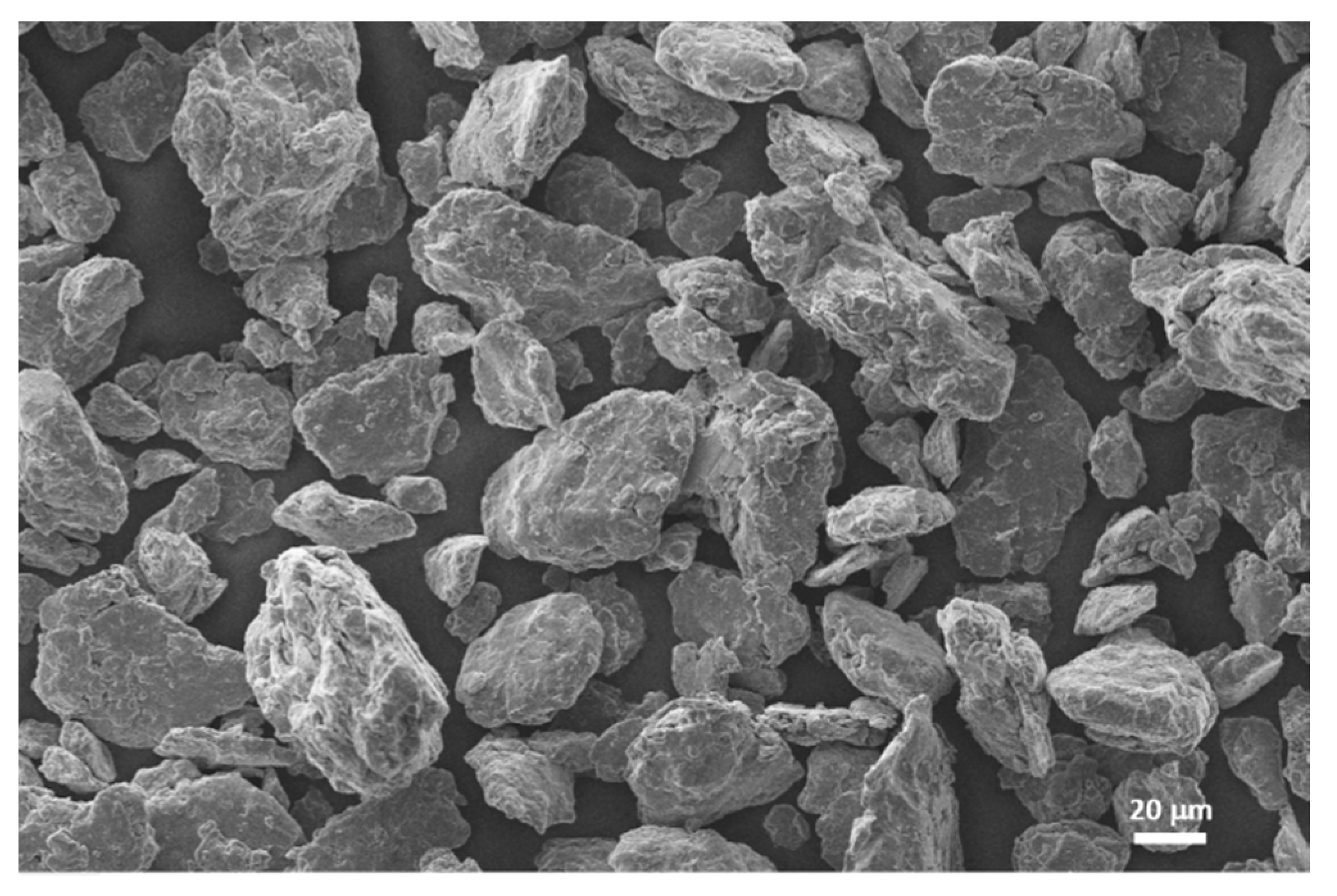

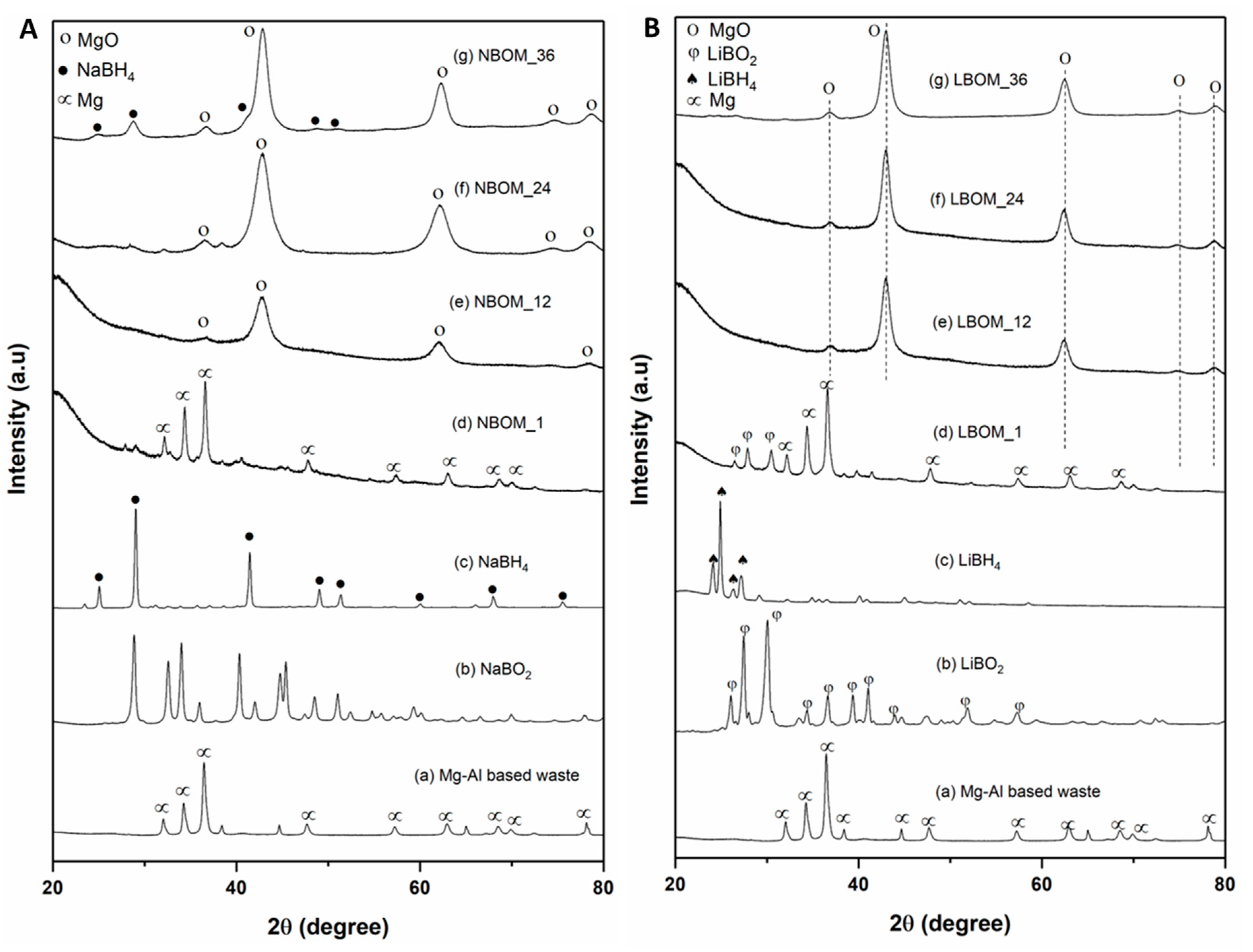
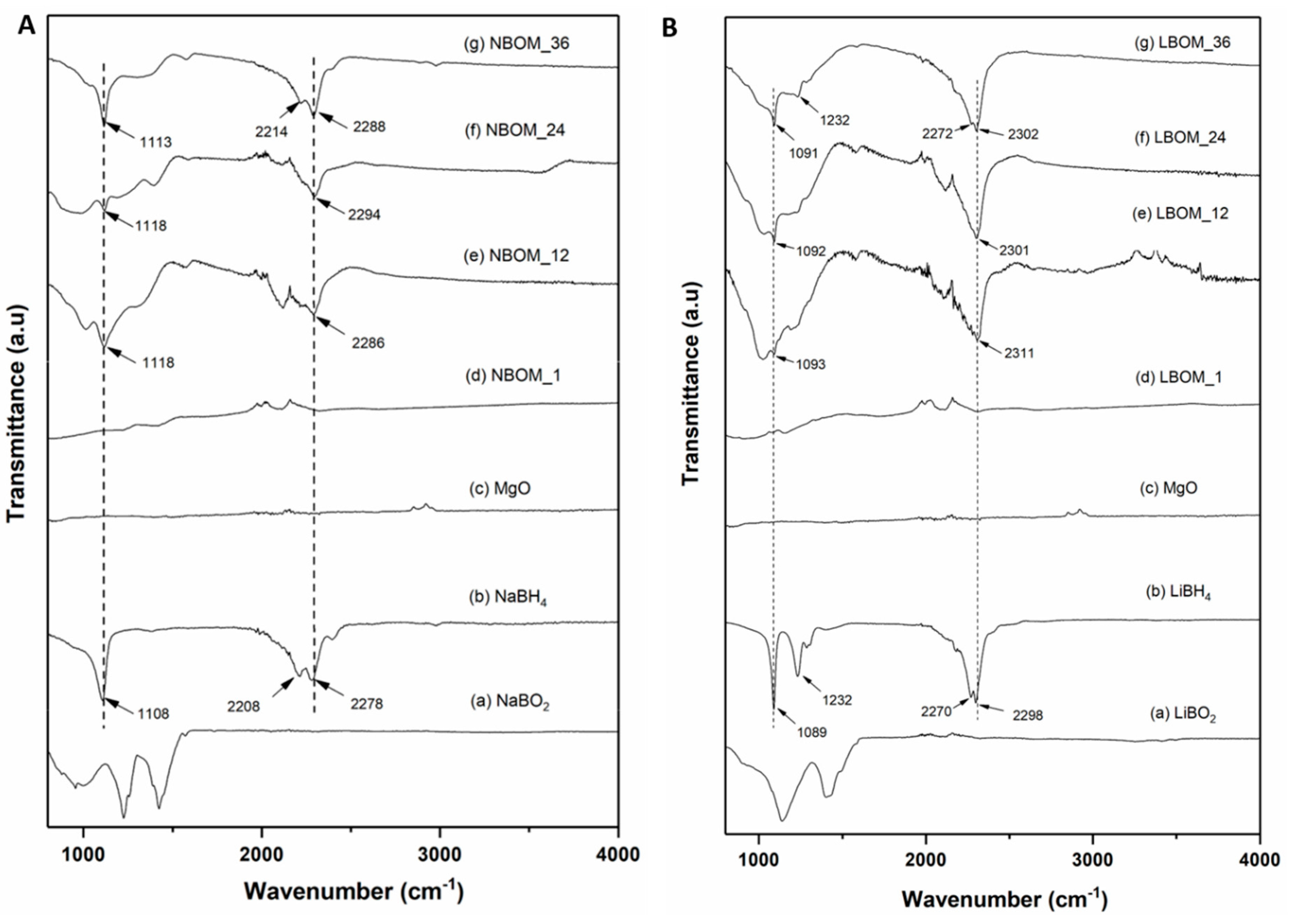
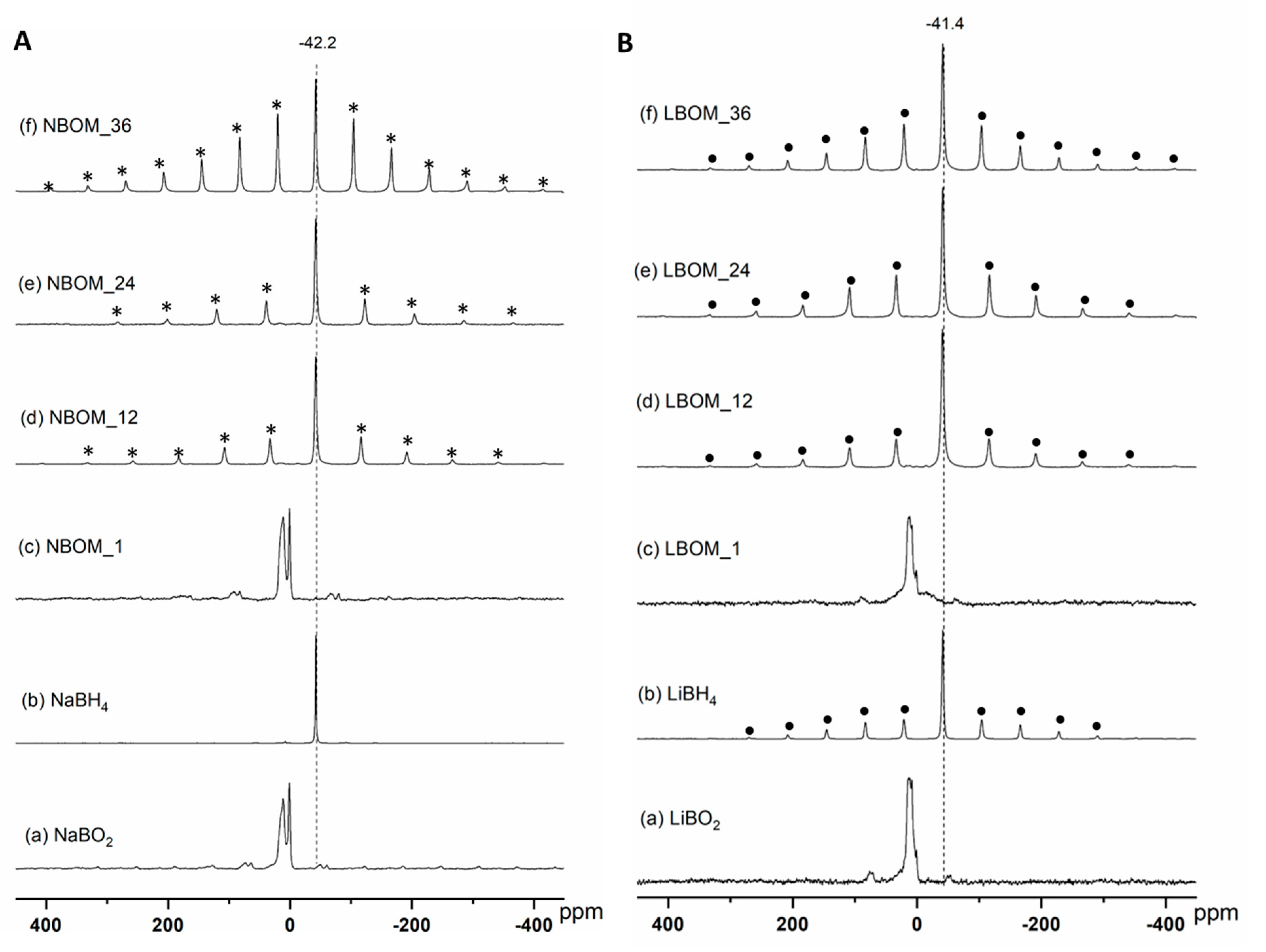
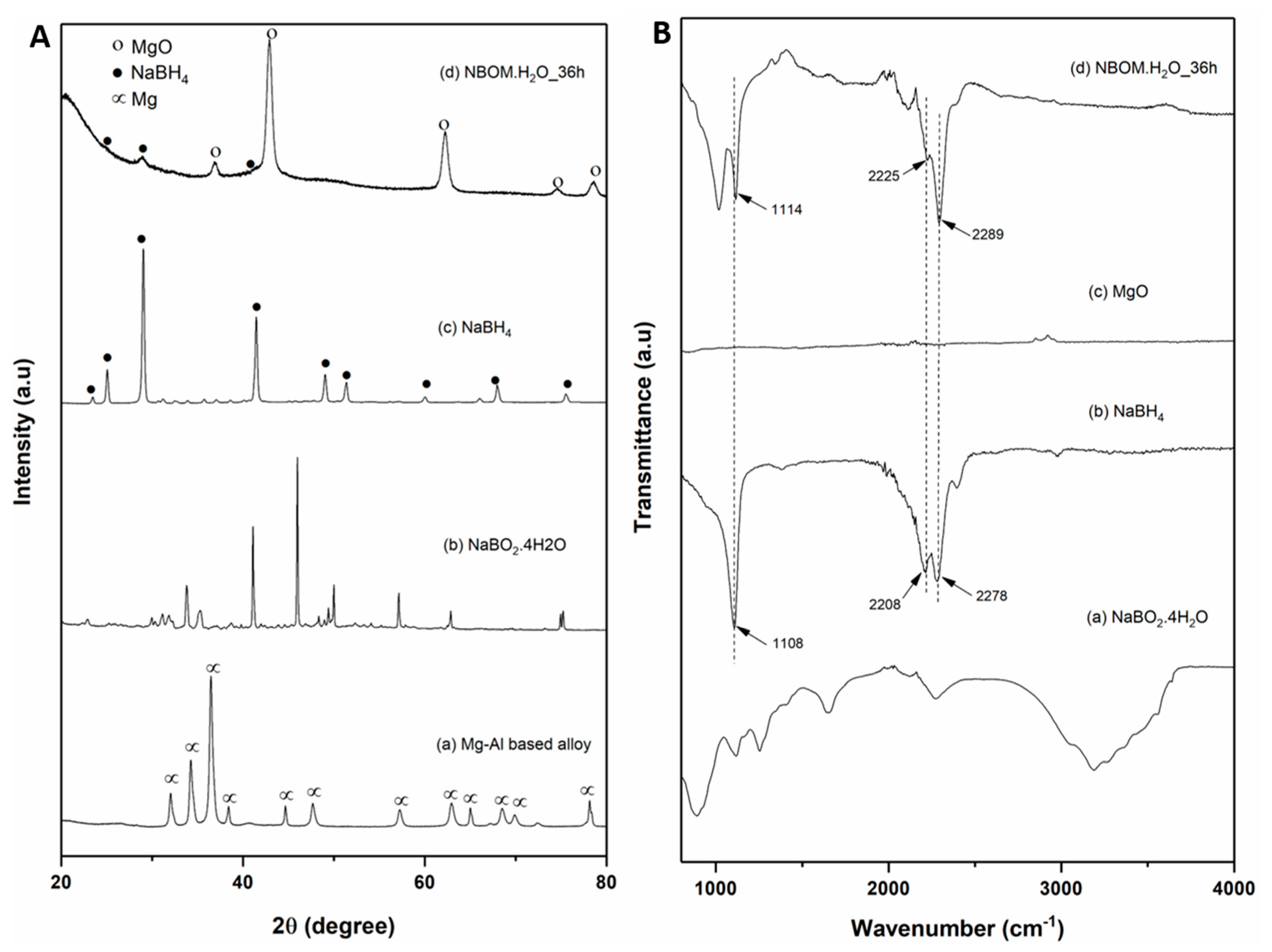
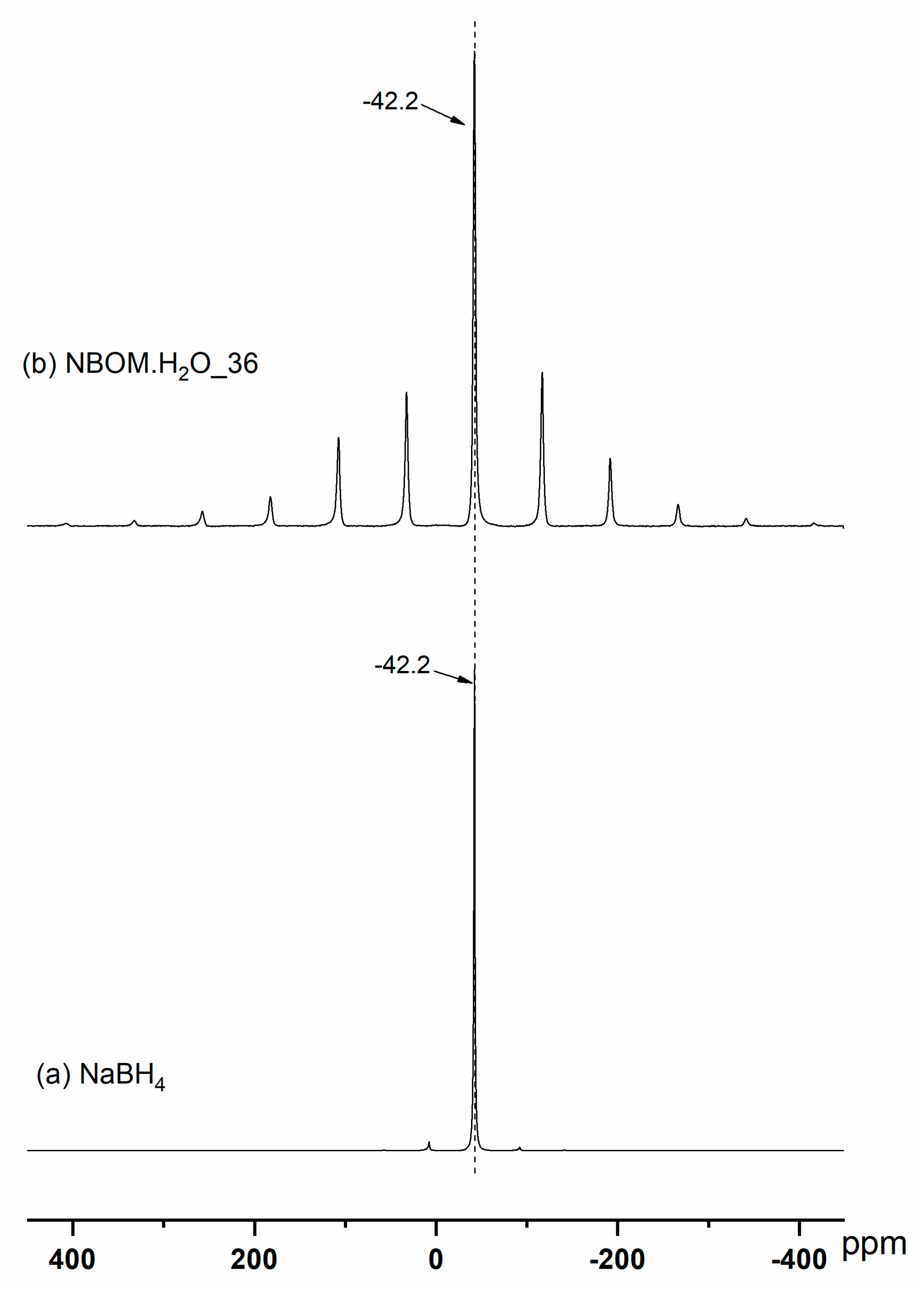

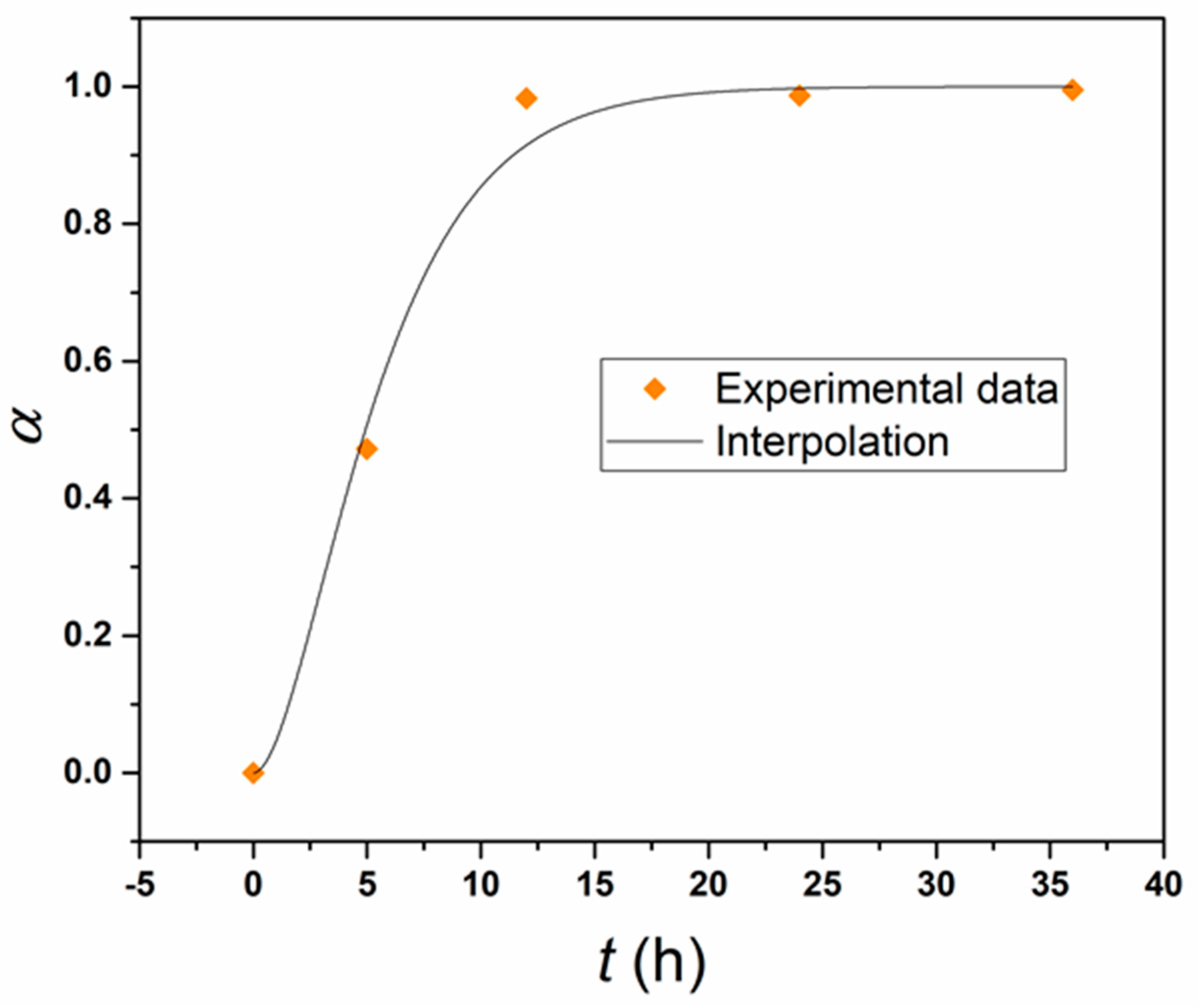
| No | Material | Designation |
|---|---|---|
| 1 | LiBO2 + Mg–Al-based waste | LBOM |
| 2 | NaBO2 + Mg–Al-based waste | NBOM |
| 3 | NaBO2·4H2O + Mg–Al-based waste | NBOM·H2O |
| System | Stoichiometric Mixture of Starting Materials | Milling Temperature | Vial Volume | H2 Pressure |
|---|---|---|---|---|
| 1 | LiBO2(s) + 2Mg(s) + 2H2(g) (Total amount of Mg–Al-based waste: 2.5 mol) | 25–40 °C | 200 cm3 | 70 bar |
| 2 | NaBO2(s) + 2Mg(s) + 2H2(g) (Total amount of Mg–Al-based waste: 2.5 mol) | 25–40 °C | 200 cm3 | 70 bar |
| 3 | NaBO2·4H2O(s) + 6Mg(s) (Total amount of Mg–Al-based waste: 7.25 mol) | 25–40 °C | 200 cm3 | 70 bar |
| Frequencies (cm−1) | NaBH4 | NaBO2 | NBOM_1 | NBOM_12 | NBOM_24 | NBOM_36 |
|---|---|---|---|---|---|---|
| B-H Bending Modes | 1108 | - | - | 1118 | 1118 | 1113 |
| - | - | - | - | - | - | |
| B-H Stretching Modes | 2208 | 1225 | - | - | - | 2214 |
| 2278 | 1423 | - | 2286 | 2294 | 2288 |
| Frequencies (cm−1) | LiBH4 | LiBO2 | LBOM_1 | LBOM_12 | LBOM_24 | LBOM_36 |
|---|---|---|---|---|---|---|
| B-H Bending Modes | 1089 | - | - | 1093 | 1092 | 1091 |
| 1232 | - | - | - | - | 1232 | |
| B-H Stretching Modes | 2270 | 1140 | - | - | - | 2272 |
| 2298 | 1420 | - | 2311 | 2301 | 2302 |
© 2019 by the authors. Licensee MDPI, Basel, Switzerland. This article is an open access article distributed under the terms and conditions of the Creative Commons Attribution (CC BY) license (http://creativecommons.org/licenses/by/4.0/).
Share and Cite
Le, T.T.; Pistidda, C.; Puszkiel, J.; Milanese, C.; Garroni, S.; Emmler, T.; Capurso, G.; Gizer, G.; Klassen, T.; Dornheim, M. Efficient Synthesis of Alkali Borohydrides from Mechanochemical Reduction of Borates Using Magnesium–Aluminum-Based Waste. Metals 2019, 9, 1061. https://doi.org/10.3390/met9101061
Le TT, Pistidda C, Puszkiel J, Milanese C, Garroni S, Emmler T, Capurso G, Gizer G, Klassen T, Dornheim M. Efficient Synthesis of Alkali Borohydrides from Mechanochemical Reduction of Borates Using Magnesium–Aluminum-Based Waste. Metals. 2019; 9(10):1061. https://doi.org/10.3390/met9101061
Chicago/Turabian StyleLe, Thi Thu, Claudio Pistidda, Julián Puszkiel, Chiara Milanese, Sebastiano Garroni, Thomas Emmler, Giovanni Capurso, Gökhan Gizer, Thomas Klassen, and Martin Dornheim. 2019. "Efficient Synthesis of Alkali Borohydrides from Mechanochemical Reduction of Borates Using Magnesium–Aluminum-Based Waste" Metals 9, no. 10: 1061. https://doi.org/10.3390/met9101061
APA StyleLe, T. T., Pistidda, C., Puszkiel, J., Milanese, C., Garroni, S., Emmler, T., Capurso, G., Gizer, G., Klassen, T., & Dornheim, M. (2019). Efficient Synthesis of Alkali Borohydrides from Mechanochemical Reduction of Borates Using Magnesium–Aluminum-Based Waste. Metals, 9(10), 1061. https://doi.org/10.3390/met9101061











